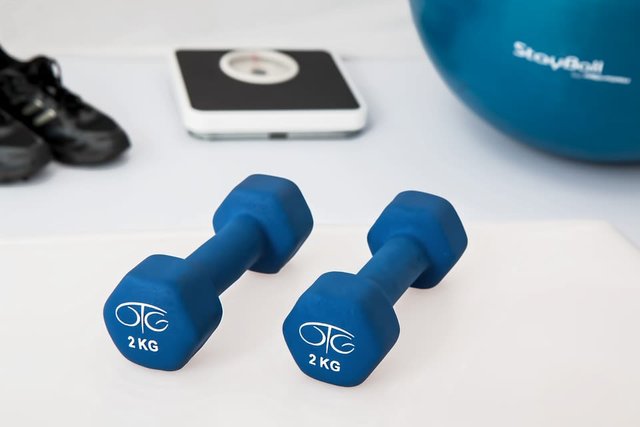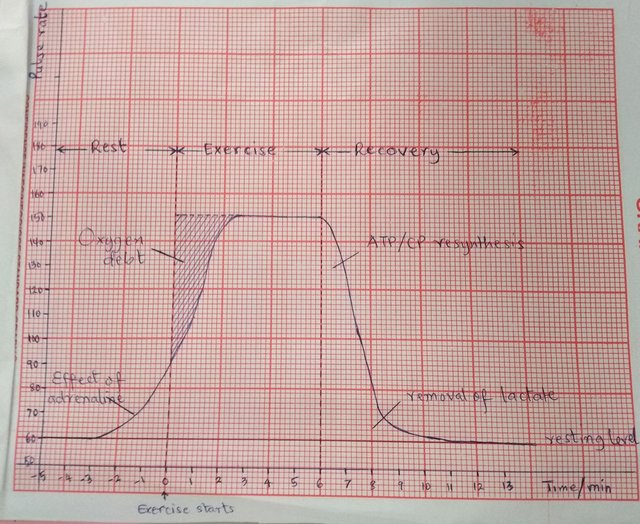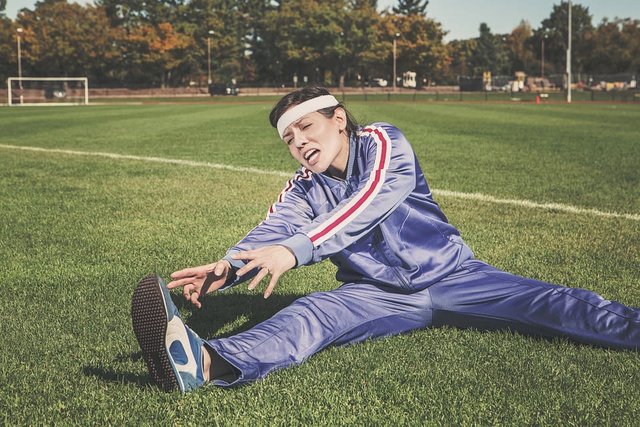EXERCISE PHYSIOLOGY #2
Good day my wonderful readers, thanks for the encouragement and constant support. A great thanks to all the @steemstem curators, most especially @chappertron, for deriving a likeness to all my articles. I do appreciate y’all. Today, I’ll discuss further on the issue of exercise physiology, explaining more on our body’s short-term and long-term responses to exercise and finally on the dangers of over-exercising.
So, let’s ride on…..

SHORT-TERM RESPONSES TO EXERCISE
Exercise places great demands on the body. Think about the changes that occur when we exercise:
- oxygen levels fall,
- carbon dioxide and lactate levels increase,
- body temperature increases,
- blood glucose and glycogen levels fall,
- fluid and electrolytes (salts) are lost as we sweat.source
All this presents a great challenge to the homeostatic mechanisms of the body. In an attempt to maintain some sort of stability, the body responds by:
- Increasing heartbeat and breathing rate. The increased respiration of the muscles raises the carbon dioxide level in the blood and consequently lowers the pH (carbon dioxide is an acidic gas). These changes are detected by sensitive cells – chemoreceptors – situated in the carotid and aortic bodies in major blood vessels. In turn, these receptors inform the cardiovascular and respiratory centre in the brain, which responds by increasing the heart rate and the ventilation rate. The result is that gas exchange increases, as does the delivery of oxygen to the tissues and the removal of carbon dioxide.
- Increased blood flow to the skin. Muscle movement creates heat that must be lost. By increasing the diameter of the blood vessels that carry blood to the skin surface – a process called peripheral vasodilation – the blood can push heat to the body’s surface, where it can more easily be lost to the environment. This is why we ‘go red’ during and after exercise.
- Increased sweating. Sweat glands secrete a salty solution that evaporates from the skin, taking heat with it. Coupled with vasodilation, sweating is a very efficient means of removing excess heat. The problem with excess sweating, of course, is that we also lose water and salts. If these are not replaced, the body becomes dehydrated and athletic performance can be impaired.
- Increased mobilization of glycogen. In order to keep the muscles supplied with glucose, the glycogen stores in the muscles and the liver start to be mobilized. Glycogen is a highly branched polymer of glucose, which breaks down rapidly to release glucose. After prolonged exercise, glycogen stores are replenished from carbohydrate in the diet.source
THE RECOVERY PROCESS
After exercise, following the short-term changes listed above, the body does not immediately return to normal. Each system gradually returns to resting levels. Generally, the fitter the individual, the more quickly the resting state is achieved.
The graphical figure below shows the pulse rate of an athlete before, during and after a session on an exercise bike. Following exercise, pulse rate follows a classic pattern; a rapid initial fall followed by slower return to normal.

A graphical illustration by me.
The shape of the curve results from two processes: the recharging of the ATP/CP system – this is known as the alactacid component of recovery – and the removal of lactate, called the lactacid component of recovery. Both occur because the body was not able Deliver enough oxygen to keep up with demand. This shortfall is known as the oxygen debt and is repaid after exercise stops.source
On a longer term basis, the body must also restore its glycogen levels. After particularly gruelling exercise session, restoring the glycogen can take up to 48 hours and is not associated with raised heart or breathing rate.
We shall look at each of these components in turn.
The graphical figure indicates the effect of pulse rate on exercise. Note that the resting pulse is about 60, normal for a trained athlete. The increase in heart rate just before exercise starts is due to anticipation, caused by the release of adrenaline: the more important the event, the more noticeable is the effect of adrenaline. When exercise starts, oxygen demand is greater than supply, and an oxygen debt builds up. This is paid off after the activity has finished.source
The alactacid oxygen debt component
This is the recharging of the ATP/CP system and takes one to two minutes to complete. Even fit people can’t sprint continually, but after a short ‘burst’ it takes only a matter of seconds before there is enough ATP/CP to allow them to sprint again.source In sports such as football, rugby, tennis or hockey, there are bursts of intense activity followed by periods of relative rest, during which the ATP/CP stores are restored by normal aerobic respiration.source
The lactacid oxygen debt component
This is the removal of the lactate ions that accumulated during the exercise. This acidic chemical lowers the pH of the blood, interfering with the enzymes in aerobic respiration and so reducing ATP supply to muscles. A significant build-up is painful, and there is only so much muscle fatigue we can take before we simply have to stop. Interestingly, one of the main effects of training is to increase our tolerance lactate, so that we can continue to exercise despite higher lactate levels.source
Lactate builds up in the muscles and diffuses into the blood. It then has five possible fates:
- 65 per cent is oxidized to carbon dioxide and water;
- 20 per cent is converted to glycogen;
- 10 per cent is converted to protein;
- 5 per cent is converted to glucose;
- a trace is excreted in urine and sweat.
The list clearly shows that the anaerobic system is rather wasteful in terms of energy. Only two ATP molecules are made per glucose molecule, instead of a potential 36 (as in aerobic respiration). The production of two lactate molecules therefore represents a great waste of potentially useful energy: when each pair of lactate molecules are broken down in the liver, 34 molecules of ATP fail to be made available to the muscles.
The removal of lactate is speeded up by gentle exercise following the main activity. The warm down has the effect of reducing muscle soreness by keeping the capillaries dilated and therefore flushing oxygenated blood through the muscles.
The table below shows the recovery times that are recommended after exercise. This information is used by trainers to work out the optimum intervals between training sessions, and between training and events. The aim is to avoid chronic (long-term) fatigue that can have a drastic effect on an athlete’s performance.source
Recommended recovery times after exhaustive exercise
| Aspect of recovery | Minimum recommended recovery time | Maximum recommended recovery time |
| restoration of muscle ATP and CP | 2 minutes | 3 minutes |
| repayment of alactacid oxygen debt | 3 minutes | 5 minutes |
| restoration of oxygen myoglobin | 1 minute | 2 minutes |
| restoration of muscle glycogen (after prolonged
exercise) | 10 hours | 48 hours |
| removal of lactic acid from muscle and blood | 1 hour* | 2 hours* |
| repayment of lactacid oxygen debt | 30 minutes | 1 hour |
*= speeded up by a warm down, i.e. if the
muscles are kept working gently, the lactate is removed more quickly.source
LONG-TERM RESPONSES TO EXERCISE
If we exercise regularly, our bodies adapt and we ‘get fit’. We feel better, look better and are able to cope easily with exercise that a few months earlier would have had us gasping in a heap on the floor. A remarkable feature of the human body is its ability to respond to exercise, making us more able to cope with our chosen activity.

SO WHAT IS ACTUALLY HAPPENING?
Observable long-term responses to exercise include changes to the heart, lungs and muscles, although the extent of the effects depends on the type of exercise done. For training to have an observable benefit, it must be above a certain intensity. Muscles must be overloaded before they begin to adapt.
For instance, if you were going to train for a rugby team, a brisk walk would be totally useless, because it would not overload your muscles. Rugby, like many sports, uses a combination of all the energy systems, and the training should reflect this balance. You would need to do endurance (cardiovascular) work as well as short and long sprints, along with training (e.g. with weights) that would exercise all of the relevant muscle groups. As the muscles adapt, the intensity of training must be increased continually, to ensure muscles are still overloaded. This is the concept of progressive resistance and ensures that the body continues to adapt and improve.source
Changes to the heart
The heart responds to exercise like any other muscle; it enlarges, although the nature of the enlargement depends on the type of exercise done. Generally, there is an increase in the size of the myocardium (all the heart muscle) and therefore an increase in the size of the chambers. Consequently the stroke volume – the volume of blood pumped with each beat – increases. As a general guide, an untrained person has a stroke volume of about 90 cm3, increasing to over 120 cm3 after training.
When the heart can pump more blood per beat, it does not have to beat as often when the body is at rest. This is why getting fitter causes a decrease in resting pulse. This can go down from about 70 in the average untrained person to less than 50. Some of the world’s top endurance athletes have a resting pulse of about 35 beats per minute.
Research also shows that exercise actually increases the strength of the blood vessels, allowing them to withstand higher pressures and reducing the risk of atherosclerosis (hardening of the arteries) later in life.source
Changes to the lungs
The strength of the respiratory muscles (internal and external intercostals and the diaphragm) is increased, allowing a greater volume of air to be forced in and out. This means that ventilation rate improves. The total lung volume (the vital capacity) and surface area of the alveoli also increases, resulting in a greatly improved rate of gas exchange. Overall, the improvements in the circulation and gas exchange systems results in an increased Vo2 (max).
Changes to the muscles
The way in which the muscles adapt to exercise depends on the type of muscle fibres involved and the nature of the exercise. Here are some of the improvements that can occur:
- As a general rule, repetitive exercise with moderate resistance (such as aerobics, or light weights) improves muscle tone and stamina. Training with greater resistance (such as heavy weights) brings about an increase in muscle size, a process known as hypertrophy. Muscular hypertrophy involves an increase in the crosssectional size of existing muscles. This is due to an increase in the number of myofibrils, the sarcoplasmic volume and in the amount of connective tissue (tendons and ligaments).
- A general improvement in performance occurs because of an improved coordination of the motor units. A significant aspect of improving skill involve the antagonistic muscles. Studies have shown that as we practise particular movements, such as a tennis serve, we get smoother and more efficient. Not only do we train the active muscle to work better, we also learn to suppress the antagonistic muscle, preventing it from interfering with the action.
- With training, muscles increase their oxidative capacity their – capacity for respiration. This is achieved by an increase in the number of mitochondría in the muscle cells, an increased supply of ATP and CP and a rise in the quantity of the enzymes involved in respiration. The ability of the muscles to store glycogen, the amount of myoglobin and the ability to use lipid as an energy store are also increased.
- The density of the capillaries running through muscles increases in response to exercise, a process called capillarization. This allows a more efficient exchange between working muscles and the blood.source
THE DANGERS OF OVER-EXERCISING
Some athletes train too much, and do not allow their bodies to recover properly between sessions. ‘Over-training’ can cause serious medical problems. In addition to poor performance and chronic fatigue, the immune system can be suppressed, leading to frequent infections, commonly sore throats and flu-like symptoms. At the end of the season, some professional footballers have been found to have a very low white blood cell count. Research shows a decrease in levels of natural killer cells phagocytes, B cells and helper T cells, It is thought that psychological stress, which leads to over-secretion of the hormones adrenaline and cortisol, also contributes to immune suppression.
Joints are damaged by exercise. The knees are particularly vulnerable, because they take most of the weight of the body and can move in only one plane. Sudden twisting and/or heavy impacts can result in ligament damage. Long-term use can result in the articular cartilage wearing away, so that bone scrapes on bone, causing pain and inflammation – one type of arthritis.

Over-training in young athletes is particularly dangerous because their skeleton and joints are still developing.source
SUMMARY
By the end of this chapter and the [previous one](), you should know and understand the following:
- Exercise places great metabolic demands on the body. Homeostatic mechanisms must cope with a much greater oxygen demand as well as a build-up of carbon dioxide and heat. In the long term, there may be a significant loss of water and salts (electrolytes) through sweating.
- Movement of muscles requires adenosine triphosphate, ATP, the chemical that supplies the muscles with the energy released in respiration.
- There are three sources of ATP: these comprise three energy systems. The most immediate is the ATP/CP, or alactic anaerobic system: ATP already present in the muscles is backed up by creatine phosphate, which is used to make more ATP instantly. The second system that kicks into action is the glycolytic or lactic anaerobic system: ATP is supplied by glycolysis and this system results in a build-up of lactate ions. The third is the aerobic system, in which energy comes from the complete oxidation of glucose or lipid.
- The duration of an event determines the type of energy system used: up to 10 seconds, the ATP/CP system; from 10 to 60 seconds, the glycolytic system: and more than 60 seconds, the aerobic system.
- In the short-term, the body responds to exercise by maintaining homeostasis. There is an increase in heartbeat and ventilation rate, coupled with vasodilation and sweating.
- During exercise we can build up an oxygen debt. This is paid off after exercise has finished, or during rest periods within the activity. This is why pulse and ventilation rates remain higher than normal even when activity has stopped. Extra oxygen is needed to replace the ATP/CP stores and to oxidize accumulated lactate.
- The long-term responses of the body to exercise are generally those that improve the body’s fitness. These include strengthening of the cardiovascular system (heart and blood vessels) and making the lungs and muscles more efficient. The overall result is a body that is better able to cope with the chosen activity.
Thanks.
REFERENCES
https://www.businessinsider.com/what-over-exercise-does-body-brain-health-2018-4
https://courses.lumenlearning.com/suny-fitness/chapter/effect-of-exercise-on-muscles/
https://prezi.com/n_rkc3cs2mzw/long-term-effects-of-exercise-cardiovascular-system/
https://prezi.com/bw8sgjbvqzqh/the-body-response-to-long-term-exercise/
https://www.ncbi.nlm.nih.gov/pmc/articles/PMC3524088/
http://thesportjournal.org/article/glycogen-replenishment-after-exhaustive-exercise/
http://www.medilexicon.com/dictionary/22982
https://infograph.venngage.com/p/97932/recovery-and-fatigue
https://acewebcontent.azureedge.net/SAP-Reports/Post-Exercise_Recovery_SAP_Reports.pdf
https://www.livestrong.com/article/127016-short-longterm-effects-exercise/
You often mention exhaustion here. What do you think of regimens like those Pavel Tsatsouline recommends, like those discussed in this Joe Rogan clip for instance. I.e. do however many reps you can, not to exhaustion, so there's always fuel in the tank, so you can do more overall. So it's like a lower intensity but longer lasting kind of exercise.
Secondly, any thoughts on whether lifting weights does away with the requirement for cardio? I once read something along the lines of: if you lift weights, your muscles grow, and those muscles will need to be maintained 24/7 by your heart, so your heart will need to be stronger 24/7 instead of whatever amount of time a typical cardio lasts, and that overall is either superior or equally good as typical cardio. Also, in nature we seem to follow this rationale: no one run marathons in nature, but they worked low intensity for longer spans of time.
Perfect, plenty helpful information again!
Thank you!
Resteem
Edit: And you realized the suggestion with the references, perfecto
This post has been voted on by the SteemSTEM curation team and voting trail. It is elligible for support from @curie and @utopian-io.
If you appreciate the work we are doing, then consider supporting our witness stem.witness. Additional witness support to the curie witness and utopian-io witness would be appreciated as well.
For additional information please join us on the SteemSTEM discord and to get to know the rest of the community!
Thanks for having added @steemstem as a beneficiary to your post. This granted you a stronger support from SteemSTEM.
Thanks for having used the steemstem.io app. You got a stronger support!
Hi @loveforlove!
Your post was upvoted by Utopian.io in cooperation with @steemstem - supporting knowledge, innovation and technological advancement on the Steem Blockchain.
Contribute to Open Source with utopian.io
Learn how to contribute on our website and join the new open source economy.
Want to chat? Join the Utopian Community on Discord https://discord.gg/h52nFrV